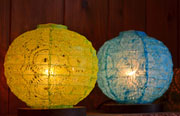Gifu and more
- Sort by
- Popularity
- Name
-
Mino ware Mino yaki
- Ceramic
- Gifu

Mino ware (called Mino yaki in Japanese) is a ceramic ware produced in the Tono area of Gifu prefecture. It has a long history and tradition but has adapted to modern life style. A notable feature of Mino ware is its wide variety of pottery. Mino …
View more
-
Mino traditional Japanese paper Mino washi
- Traditional Japanese paper
- Gifu

Mino washi is a type of Japanese paper made in Gifu prefecture. Washi is made from paper mulberry which is a plant that grows in the city of Mino, a place of abundant forests. Ancient manuscripts in the Shosoin Repository* indicate the history of …
View more
-
Beppu bamboo crafts Beppu take zaiku
- Wood, bamboo crafts
- Oita

Beppu take-zaiku are bamboo crafts produced in the city of Beppu, Oita prefecture mainly from odake bamboo* grown and harvested locally. This craft is entirely handmade and uses a distinctive range of basic weaving techniques. It is also the only …
View more
-
Gifu lanterns Gifu chochin
- Other crafts
- Gifu

Gifu lanterns (called Gifu chochin in Japanese) are produced in the city of Gifu, Gifu prefecture and have a history of over three hundred years. In 1995, their high level of craftsmanship was recognized with a designation as a National Traditiona…
View more
-
Ichii woodcarvings Ichii itto bori
- Wood, bamboo crafts
- Gifu

Ichii woodcarvings (called Ichii itto bori in Japanese) are produced in the Hida region of Gifu prefecture, and made only from the wood of ichii (Japanese yew), the prefectural tree of Gifu. The ichii tree gets its name from a scepter made of Japa…
View more
-
Hida-shunkei lacquerware Hida shunkei
- Lacquerware
- Gifu

Hida-shunkei lacquerware is produced around the city of Takayama in Gifu prefecture. The name is said to come from the fact that the articles produced initially had a similar coloring to Hishunkei tea containers. This craft is notable for having …
View more
-
Gifu Japanese Umbrellas Gifu Wagasa
- Other crafts
- Gifu

Japanese umbrellas are not only used on rainy days or as parasols, but there are also umbrellas used for dancing and larger parasols called nodategasa used for outdoor tea ceremonies. They become very slim and delicate when they are closed, and t…
View more
- 1

































































































































































































































































































